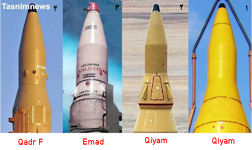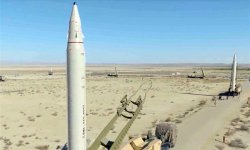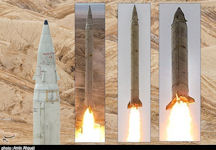Emad
 Emad ballistic missile is the Iranian liquid-fuel long-ranged ballistic missile equipped with a guided warhead by installing vanes ["balks"] on the Emad warhead. The Emad ballistic missile can carry a 750 kg payload at a range of 1700 km. Once Emad's reentry vehicle enters the atmosphere, they can start to maneuver and alter their trajectory. This is done to increase precision and to perform random evasive maneuvering.
Emad ballistic missile is the Iranian liquid-fuel long-ranged ballistic missile equipped with a guided warhead by installing vanes ["balks"] on the Emad warhead. The Emad ballistic missile can carry a 750 kg payload at a range of 1700 km. Once Emad's reentry vehicle enters the atmosphere, they can start to maneuver and alter their trajectory. This is done to increase precision and to perform random evasive maneuvering.
A September 2024 report shared exclusively with The Associated Press suggests one of the advanced missiles Tehran would use in any future attack against Israel is far less accurate than previously thought. Analysts at the James Martin Center for Nonproliferation Studies examined the Iranian strike on the Nevatim Air Base some 65 kilometers south of Jerusalem in the Negev Desert. Assuming Iran targeted Israeli F-35I fighter jet hangars, the James Martin analysts measured the distance between the hangars and the impact zones of the missiles. That gave an average of about 1.2 kilometers for the “circular error probable”. That’s far worse than a 500-meter error circle first estimated by experts for the Emad. Iran separately advertised the Emad to potential international buyers as having a 50-meter circle.
Emad is variant of Imad and has the exact same meaning and pronunciation. Either Emad or Imad, both are correct and acceptable. Emad is a direct Quranic name for boys that means “pillars”. It is usually short for Emad ad-Deen, which means “pillars of the religion”, i.e. a person who is a strong supporter of Islam. The word Emad is mentioned in the Quran in 89:7: "Iram, the civilization that had pillars, the like of which were not created in any other city." (Quran 89:7-8)
This missile is the first long-range missile of the Islamic Republic of Iran with the ability to guide and control until the moment it hits the target; which is able to hit the desired targets with high precision and destroy them completely. All the stages of design and construction of Emad ballistic missile have been done by scientists and specialists of Aerospace Industries Organization of the Ministry of Defense.
In response to the Israeli attack on Iran's consulate building in Syria on April 1, the Iranian Islamic Revolution Guards Corps (IRGC) fired dozens of missiles and drones on Israeli targets on 13 April 2024. Iran’s anti-Israel operation was conducted by Shahed 131/136 Unmanned Aerial Vehicles (UAVs), Kheibar Shekan ballistic missiles, Emad ballistic missiles, and Paveh cruise missiles. Five to ten minutes before the surviving drones and cruise missiles were to reach their intended targets in the occupied territories, Iran launched the main weapons of the ‘True Promise’ operation. The ballistic missiles were not launched simultaneously on purpose to reduce the shock effect on Israel's missile defenses. Surviving drones and cruise missiles put additional stress on the radars and sensors, creating completely different targets at lower altitudes.
Descending from space like meteors, Ghadr and Emad would have first faced Israel's Arrow-3 missile interceptors, as well as U.S. SM-3. Those older Iranian missiles mainly defend themselves with inflatable decoys in space. The expensive and advanced American AN/TPY-2 could have helped Israel's missile defenses to identify which objects were warheads, which empty spent boosters, and which were decoys. In the chaos of ballistic missiles’ re-entry vehicle housing the warhead, spent booster stages, and submunitions released by Ghadr, Emad missiles would also have released their decoys to survive against Arrow-3 and SM-3.
Emad would rely on a short atmospheric flight time, enabled by a steep dive trajectory, plus random evasive maneuvering. Arrow-2, Patriot and David-Sling are the systems that tried to intercept the maneuvering Emad’s re-entry vehicles. Emad missiles were also fast and glowing objects descending and impacting at 6-7 times the speed of sound. The slow glowing objects seemed to be the submunitions of Ghadr and the slow objects in flame were likely the separated empty booster stages.
Imad is a single-stage liquid fuel missile with a detachable warhead, which was developed based on the Qadr missile. The Emad missile can carry a maximum of 500 kg of high-explosive materials. The presence of a detachable warhead that can be guided by four control blocks or canards has brought high accuracy to the Emad missile. This missile has the ability to launch from fixed and mobile platforms, and its nose is equipped with control and guidance systems and sensors. The length of this missile is 15 and a half meters and the diameter of its body is about 1 meter and 25 centimeters. The Emad missile has a weight of more than 17,000 kg, and the weight of its warhead is estimated at only 750 kg.
Iran’s Defense Minister Brigadier General Hossein Dehqan said 11 October 2015 the Islamic Republic successfully test-fired a new long-range ballistic missile, dubbed Emad. Speaking to reporters , Dehqan said the surface-to-surface missile has been completely designed and manufactured by experts of Iran’s Aerospace Industries Organization affiliated with the Iranian Ministry of Defense. Emad is Iran’s first long-range missile with guidance and control systems which can hit targets and completely destroy them with high precision, the Iranian minister added. The Emad surface-to-surface missile was completely designed and manufactured by experts of Iran’s Aerospace Industries Organization affiliated with the Iranian Ministry of Defense.
The Iranian defense minister said Emad would be mass produced and delivered to missile units of the Iranian Armed Forces soon to significantly enhance their tactical and operational power. The Islamic Republic has repeatedly said that its military might poses no threat to other countries, reiterating that its defense doctrine is merely based on deterrence.
The Iranian defense chief said that the JPCOA has not banned Iran from boosting its defense capabilities. He also stated that Defense Ministry pursues a strategy based on developing and increasing the missile capabilities of the Iranian Armed Forces and enhancing the Islamic Republic’s deterrent power. “We do not ask for permission from anybody to increase our defense might and missile capability and are decisively following up our defense plans, particularly in the missile sector,” Dehqan said, emphasizing that the manufacturing of Emad is an apparent example of such a strategy.
Iranian Defense Minister Brigadier General Hossein Dehqan said 16 December 2015 the recently test-fired precision-guided long-range Emad missile is a conventional armament. “We consider defense as our inalienable and recognized right and will continue to design, manufacture and put into operation any necessary conventional weapons and equipment in order to defend the country,” Dehqan said on Wednesday. Dehqan's remarks came a day after a panel of UN experts said in a confidential report that Iran’s firing of the long-range ballistic missile in October violated a UN Security Council resolution, alleging that the missile is capable of delivering nuclear weapons.
“On the basis of its analysis and findings the Panel concludes that Emad launch is a violation by Iran of paragraph 9 of Security Council resolution 1929,” the panel said. But Dehqan said, "Our aim of carrying out this test was that we wanted to tell the world that the Islamic Republic of Iran acts based on its national interests and no power anywhere in the world can decide for our nation and country and [Iran] will not accept any restriction on this issue.”
The Iranian defense minister said that despite certain restrictions stipulated in the UN Security Council Resolution 2231 under the terms of a July nuclear agreement between Iran and six world powers Tehran will keep boosting its defense capabilities. Iran and the five permanent members of the United Nations Security Council – the United States, Britain, France, China and Russia – plus Germany finalized the text of the agreement dubbed the JCPOA in the Austrian capital Vienna on July 14. On July 20, the UN Security Council adopted Resolution 2231, which bars Iran from developing missiles "designed to carry nuclear warheads."
At that time, some Lebanese media attributed the name of Iran's most accurate long-range missile to the martyrdom of Emad Mughniyeh. Emad was the first missile built and unveiled in October 2014 after the nuclear agreement, which attracted the attention of domestic and foreign experts and media and had many reactions at the international level. "Kalam Elium" news site, presenting a report in this regard, announced that this missile test was "successful" and was able to target the desired targets with high accuracy. The precision in the construction of this missile and its indigenous nature without the participation of any foreign country attracted the attention of the world's media.
The "Naba" news agency also wrote in the headline of the published report about the Emad missile that "Tehran added the Emad to its ballistic missile stockpile." "Emad" is able to destroy targets from a long distance. At the end of its report on the Emad missile test, the Saudi Al-Hiyah base wrote that Iran's action could be a threat to the Arab countries of the region. In its report on the missile capability of the Islamic Republic of Iran, Al-Laft news website wrote: Iran's long-range missiles have been envisioned for 10 years and have successfully passed their tests. It takes ten minutes to reach the occupied territories.
The Zionist newspaper Ha'aretz reflected the news of the successful test launch of the long-range surface-to-surface ballistic missile Emad. According to this newspaper, the range of this missile and its accuracy are not known, but it is said that it can be controlled until the moment it hits the target. CNN, while publishing the news of the successful test of the Emad missile, said that this long-range ballistic missile was designed and built by Iranian experts, which, according to Iran's defense minister, can be controlled until the moment it hits the target.
Referring to the news of the unveiling of the Emad missile, the French news agency wrote that this missile was tested while some Iranian officials had announced months ago that the Islamic Republic's recent nuclear agreement with world powers may impose restrictions on the country's missile program. Iran has announced that its missiles will never carry nuclear warheads, because Tehran has no plans to produce nuclear weapons, but Iranian military officials have emphasized the development of the country's missile program.
One of the prominent experts of the Zionist regime's missile defense announced: Iranians have the ability to install warheads on ballistic missiles and can greatly increase the accuracy of their missiles and have a missile with a range of 2000 km with the ability to attack accurately. They have found that they easily paralyze the enemies of this country.
Members of Parliament praise the Ministry of Defense for the successful test of the "Imad" missile. After the successful test of the Emad ballistic missile, 220 members of the Islamic Council expressed their appreciation and support for the successful test of the missile. The successful test of the Emad long-range missile had a wide coverage in the international media. While acknowledging Iran's missile capability and continuing its Iran-phobic policies, the Western and especially the American media claimed: The test of this missile has violated the nuclear agreement between Iran and the 5+1 group!
In the exercise of the Great Prophet (PBUH) 17, the Islamic Revolutionary Guard Corps Aerospace Force once again practiced combined drone and missile operations, and in this exercise, a 200 x 180 meter replica of the Zionist regime's nuclear power plant known as Dimona was targeted by suicide missiles and drones. The Defense Group of Tasnim News Agency - the series of drills of the Prophet (PBUH) has alwaysbeen a reminder of the news of some of the most important defense achievements of the country; From the Huot missile torpedo in 1384 to the acquisition of maneuvering warheads for ballistic missiles in 1400, this was the news that was announced by the commander of the Islamic Revolutionary Guard Corps Aerospace Force in the last stage of the exercise,
Until 2014 and the unveiling of the Emad missile, the warhead of Iranian long-range missiles only reached the accuracy obtained from the missile's navigation and guidance systems, and after being separated from the missile body, they could no longer correct the path and increase the accuracy. Of course, in the short-range and short-range tactical missile category, the Fateh missile family had the ability to guide to the end of the path. With the operationalization of the Emad missile, whose detachable warhead had a guidance and control system until the end of the path, Iranian long-range missiles entered the proud path of increasing accuracy to the point of pinpoint accuracy, which was praised several times by the Supreme Leader of the Revolution and the Supreme Commander of the Armed Forces. This capability was then extended to the Qadr, Qiyam and Khorramshahr family missiles, and even the Shahab 2 missiles did not benefit from this development.
The development of ballistic warheads with the ability to maneuver in the final phase causes the enemy's system to have difficulty in predicting the path by leaving the warhead out of the conventional ballistic trajectory and moving on paths that do not have a clear order, thus making it possible to counter The enemy's missile defense shield is reduced to almost zero, and the problem that happened to the Patriot in 1991 is systematically created this time.
The warhead of the Qadr F missile is similar to the detachable part of the warhead of Qiyam and Sajil missiles. The new warhead has more height and volume in the lower conical part, which can be the location of a propellant. For comparison, the simple guided type of three-cone warheads with control wings is related to the Qiyam guided missile. Despite the difference in dimensions, the new warhead (picture 2) is designed to be compatible with existing missiles, as a result of which all Qadr, Sajil and Qiyam missiles can be used effectively against targets protected by missile defense systems such as Patriot, Arrow, Thaad and Aegis are helping to start a new war.
The design and construction of such a warhead, from various aspects, including the design of the dynamic path and its calculations, the resistance of the structure against the strong inertial forces caused by the rapid change of direction, the construction of guidance and control systems with a very high response speed that responds to a projectile with a hypersonic speed (more than five times the speed of sound or above Mach 5) and of course hitting the intended target precisely at the final point is much more difficult than guided warheads, but the country's missile scientists have overcome these problems only 6 years after the unveiling of Emad. They have taken a very important step towards increasing the effectiveness of the country's missile power in the desired military equations of Islamic Iran.
Maneuverable ballistic warheads are only one step away from warheads or hypersonic gliding vehicle (HGV: Hypersonic Gliding Vehicle) warheads, which are currently considered the cutting edge of missile technology in the warheads sector. This type of projectile is different from maneuvering warheads only in its design and flight path, and its speed varies from Mach 5 to 20 depending on the design and opinion of the manufacturer. HGV projectiles, instead of gaining height like ballistic projectiles, travel at a much lower height with the possibility of changing the direction of the target frequently, and as a result, the early warning radars of the enemy's defense have problems in identifying them, and the probability of surprising the enemy's missile defense system is much higher.
| Range | 1700 km |
| Weight | 17500 kg |
| Length | 15.5 meters |
| Diameter | 125 cm |
| Fuel type | Liquid |
| Warhead | 750 kg |
| Speed | Mach 11 |
| Flight path | Ballistic |
| Range of error | |
| Flight ceiling | 400 km |
| System | Inertia guidance with Winged cap to guide until the moment of hitting |
| launch pad | fixed and movable |
|
NEWSLETTER
|
| Join the GlobalSecurity.org mailing list |
|
|
|





